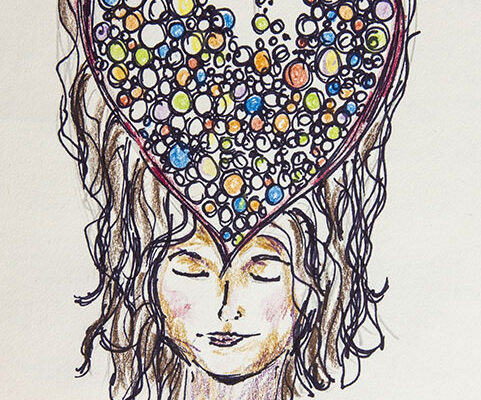“On the road again, goin’ places that I’ve never been. Seein’ things that I may never see again,” sang country singer Willie Nelson (1980, August). In fact, inmates live this transient life. Many inmates start out “couch surfing,” and become homeless, living in tents. At the point of incarceration, most have more than worn out the welcome mat with family and friends. Doing time means “getting 3 hots and a cot,” that is 3 meals and a bed which is more consistent than when living free.
In a Blink of an Eye
With no schedule living “on the streets,” inmates come into incarceration and experience the same bouncing around, with constant dorm or facility reassignments. Some may get released; some are retained for a lengthy court trial and many go to prison. Inconsistency is the consistency. As a result, planning art therapy services becomes challenging with all the movement.
Re·cid·i·vism
Over time, it’s easy for facility staff to become hardened and jaded. Especially when witnessing the reoffend cycles. These cycles are measured by recidivism, which is basically a measure of the time before relapse and reconviction. Generally, an inmate with a long rap sheet may recidivate more quickly or younger inmates may recidivate more quickly than older inmates (National Institute of Justice, n.d.). When starting therapy groups, I was doubtful about establishing regular patients. To my surprise, I maintained a steady group of inmates awaiting sentencing. Also, I witnessed many group members voluntarily return to therapy sessions months later upon rearrest.
Lather, Rinse, Repeat
One inmate had a history of heavy drug use and domestic violence. While in jail he gained back a healthy weight, but returned months later and 40 pounds lighter after a return to his usual lifestyle. Another inmate had a college degree but maintained an extensive history of arrests. Seeing the pain of pattern and witnessing the cycle on repeat can be exhausting. The fog of extensive drug use, toxic relationships, complicated lives and trauma appears as perfunctory as a morning shower, just lather, rinse, repeat.
Emotions Made Tangible
The emotional toil is heavy especially when made tangible through physical signs. Bloody eyes, cuts, bruises, busted lips, poor skin tone, missing or broken teeth, tremors, the list goes on. Further, suicidal gestures often come into this mix and must be evaluated for valid attempts or manipulation for other services. According to the Bureau of Justice Statistics, suicide is the leading cause of death in jail, with jail rates superseding that of prison and the general population (2020).
Art Therapist with Conviction
So, how do you cope in the corrections environment? As an art therapist, reflective artmaking helps by enabling painful feelings to become tangible and eventually manageable.
How Are You?
Helpless in a hopeless system
Staring into the pain of shock
How can this happen on this block?
Justice is distanced to the powerless
Caught in process & brokenness
Sea of red pooling
Encircling the soul
Shock, horror and why bestow —
None are blameless, you know.
But some lines should never be crossed
Otherwise humanity is tossed
An innocent “how are you”
Now becomes misconstrued
For stories shared in close proximity
Reveal this needless calamity
Egos and power struck down
Edging God out of this town.
Those left in the wake of wrath
Must now pick up pieces for a path
To take them out of bodily pain
In hopes to erase the mental strain
Of another complication
Too difficult a situation.
Breathe in breath of life…
Help lessen this strife…
May blood tears dry up this grime
So wrongdoings can fit their crime.
In my reflective poem and image “How Are You?,” I drew the pain that I witnessed. Bloody red paint was applied with a layered, dense wash. With the defined bulging eyeball and purplish-yellow bruising, the image is painful to look at. Art provided me some distance. More important, the image and poem provided me a voice; yet I never uttered a word.
References
Department of Justice. Office of Justice Programs. Bureau of Justice Statistics. (2020, February). Mortality in Local Jails, 2000-2016 –Statistical Tables by E. A. Carson and M. P. Cowhig. Washington DC: Bureau of Justice Statistics. Retrieved from the Bureau of Justice Statistics Web site: https://www.bjs.gov/content/pub/pdf/mlj0016st.pdf?utm_content=mci&utm_medium=email&utm_source=govdelivery
National Institute of Justice. (n.d.). Recidivism. https://nij.ojp.gov/topics/corrections/recidivism
Nelson, W. (1980, August). On the road again. Honeysuckle Rose. [Vinyl record]. New York City, NY: Columbia Records.




